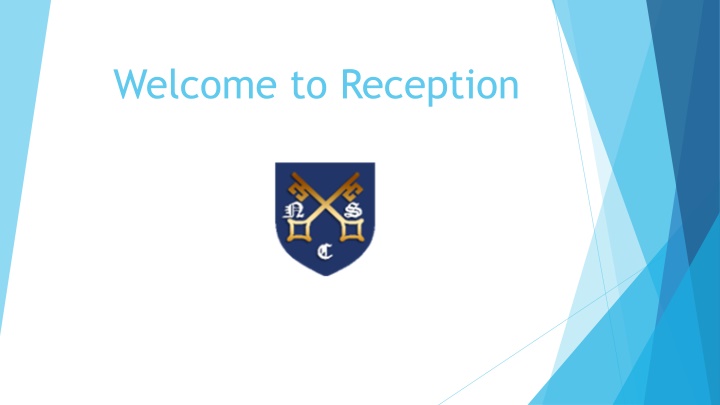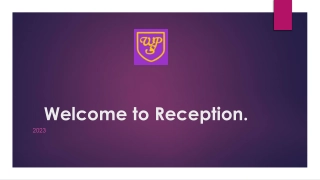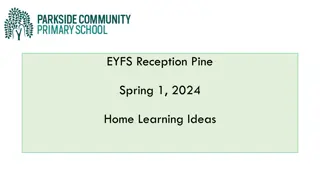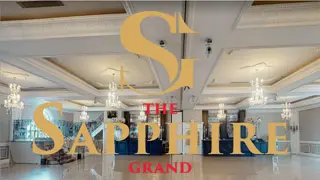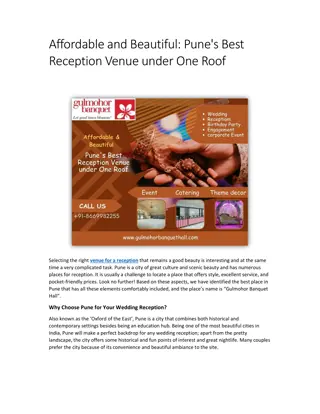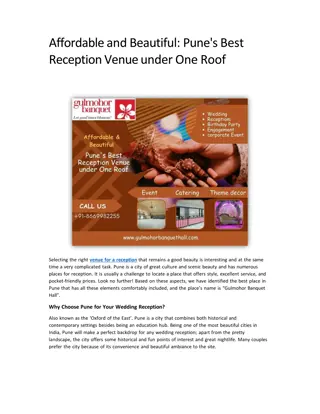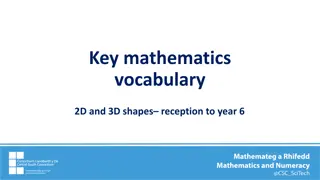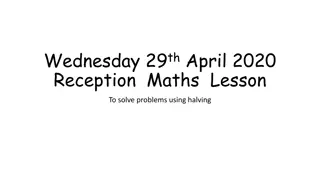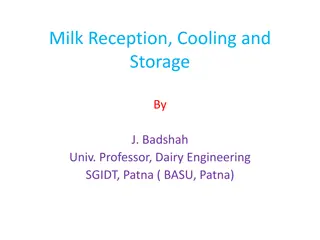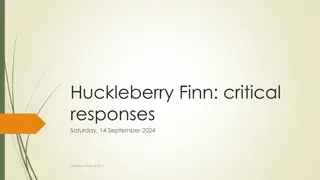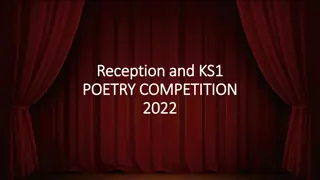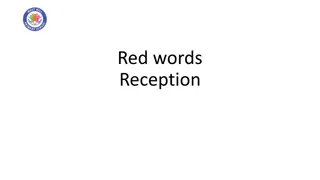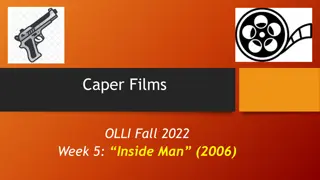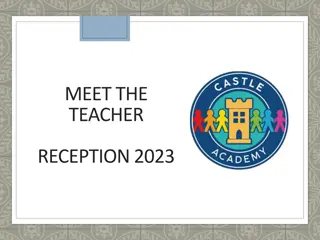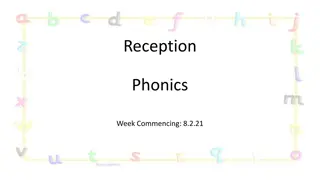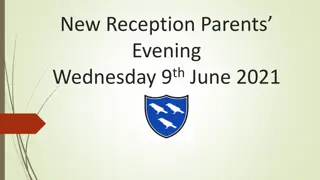Welcome to Reception
In Reception, parents are welcomed to join their children in the first week to help them settle into the routine. Children engage in various activities to develop fine motor skills and learn through play. The schedule includes literacy, math, free flow time, storytelling, and more. The team encourages independence by having children put away their bags and water bottles. Providing insights into the first few days, what to bring, and the daily routine, this guide offers a comprehensive overview for a smooth transition into Reception.
Download Presentation

Please find below an Image/Link to download the presentation.
The content on the website is provided AS IS for your information and personal use only. It may not be sold, licensed, or shared on other websites without obtaining consent from the author.If you encounter any issues during the download, it is possible that the publisher has removed the file from their server.
You are allowed to download the files provided on this website for personal or commercial use, subject to the condition that they are used lawfully. All files are the property of their respective owners.
The content on the website is provided AS IS for your information and personal use only. It may not be sold, licensed, or shared on other websites without obtaining consent from the author.
E N D
Presentation Transcript
Friendly Faces in Reception Here are the Reception Team Mrs Brooks: Class Teacher Mrs Kendall: Class TA
What to bring with you Book bag Water bottle A piece of fruit (we do provide fruit) A spare change of clothes. We will provide each child with a small coloured bag, which we will put their spare clothes into. If they need changing, this will be the bag that goes home with them. Please could it then be returned to us with fresh clothes as soon as possible. A packet of baby wipes is also really helpful to keep in their spare clothes bag too, as we do run out of these. We are discouraging children from bringing rucksacks into school due to the lack of space in the cloakroom. Please can children just bring their Nutfield Church book bags with a name keyring to identify it. Children will not need to bring PE kits to school for the first half term.
The first few days Wednesday 4thSeptember: Group 1: Henry, Betsy Jones, Bonnie, Tilly, Amelia, Joseph, Albie, Rosie, Jada, Taylor Thursday: 5thSeptember: Group 2: James, Isabella, Toby, Lucas, Theodore, Charles, Max, Tommy-Arlo, Ava, Gabriel Friday 6thSeptember: Group 3: Winston, Carmen, Coco, Betsy Stacey-Clear, Jude, Francesca, John, Oscar, Evelyn, Archie Monday 9thSeptember: All children in school During your child s first week at school we will be welcoming parents into the classroom to help them settle them in. When you hear the tambourine this will be your signal to say goodbye. From Monday 9thSeptember please could you line your child up on the playground and we will greet them from there.
A Day in Reception Class 8.45 9.00: Settling in time / Funky Fingers / Registration 9.00: Literacy 9.20 10.30: Free Flow (rolling snack) 10.30: Collective Worship 11.00: Phonics 11.30: Hand washing / Story Time /Nursey Rhymes 11.45: Lunch 1.00: Maths 1.15 2.45: Free Flow (rolling snack) 3.00: Story Time 3. 15: Home time.
Settling in during the morning When the children first arrive in the morning we encourage them to develop their fine motor skills by using the threading, pegs, pencil control, cutting and playdoh which is on offer to them. As well as completing the above activities the children will be quickly encouraged to get into the routine of independently putting their water bottles and bags away. The children will also be encouraged to find their names and self register. Once we are sat down for the register, we talk about the days of the week and look at the calendar. This allows the children to practice their number recognition and their counting. We also look at our visual timetable so the children know what they are doing the day.
Free-flow We have long uninterrupted times in the morning and afternoon for the children to explore their learning and their interests. This is a time when the children decide whether they want to go outside or stay in their classroom. Each area has carefully planned activities which are linked to the theme of the term. The children are also encouraged to be independent and select when they want their fruit during the morning or afternoon. Free-flow is a chance for children to explore their own interests but also practice and consolidate learning from their previous inputs. During this time children are observed and assessed against the area of learning or development statements. Then using the children s interests and their level of development we plan ways to support them further in order to strengthen and deepen their learning. We also observe how children learn and this is through the characteristics of effective learning: playing and exploring, active learning and creating and thinking critically.
Lunchtime Children go to the hall for their lunch. The class teacher stays with the class until 12.00. After 12.00 the children are looked after by Mrs Kendall, the class TA who will feedback to the class teacher any incidents or successes with eating at lunchtime. The children are encouraged to use their knives and forks and try new foods. After their lunch the children are brought outside to play in the playground and depending on the weather they can go on the climbing wall, trim trail or field. This is a really lovely time for the children as they get to see all the school together and spend time. Menus can be found on the school website.
Phonics Following an update from the Department for Education around phonics teaching we have moved to Essential Letters and Sounds, this is a phonics programme based on Letters and Sounds (2007). This new phonics programme will support your children in making quick progress to become fluent and confident readers. At the start of each session the children will be encouraged to gather their white boards pens and rubbers. We start each lesson by learning the phoneme, that is all about how we pronounce the sound. Then we identify or talk about items that have that sound either at the start, in the middle or at the end. As part of our lesson the children also learn the grapheme. A grapheme is a letter or groups of letters which represents a sound (phoneme) in writing. We all have a really good go at writing the grapheme. Children also learn how to segment sounds to help them to sound out words when spelling and blend sounds to support when reading.
Reading Books and Records We will be reading with your children on a 1: 1 basis during the morning. All children will be read with twice a week and they will have a set day when they are read with. Please read with your child daily and write a message in their reading record books. These will be checked when your child is read with. The message does not need to be lengthy, just let us know what they did well or what they need more support with. Children will receive two reading books a week as well as an online book which will be accessible through the Essential Letters and Sounds ebook library
Reading The first books that will have just come home are picture books with no words. This is to encourage the children to look at the pictures and use their imagination and inference skills to tell a story. This helps when they have a picture book with words as they then have the strategy of using the pictures to help them. We also do this so that the children get into a routine of sharing a school book with an adult, handling books, holding them the right way up and starting from left to right. The next books will have one or two words per page, these aim to build up their understanding of linking the picture to the words which will become really important later on. The words will be linked to the phonemes they will have learnt at school. After that the children start the reading scale that will follow them into Years 1 and 2. We like the children to have read at least half the books in each book band before moving them onto the next stage. Spending 10 minutes a day reading with your child will hugely support them on their journey to becoming an independent reader.
Decodable readers In addition to your child s reading book we ask that you read the decodable text provided by the school four times across the week. These books will be accessible through the Essential Letters and Sounds ebook library, which we will be providing the log-in details for in due course. We will set this book once a week on Fridays. This will allow your child to re-read each text several times, building their confidence and fluency. This is especially important as they begin to learn that the sounds within our language can be spelled in different ways. For children, re-reading words and sentences that they can decode (sound out) until they are fluent (read with ease and precision) is a key part of learning to read. By reading texts several times, children have the greatest opportunity to achieve this fluency. These texts are carefully matched to the teaching taking place in school. Your child will be practising what they have been taught in school with you at home.
Literacy Literacy is split into three areas Comprehension / Word Reading / Writing We have four literacy lessons a week and one teacher-led literacy lesson in a small group of three children. These lessons will be linked to a story, a non-fiction text or a poem. We will also show the children how to use story mapping and innovation to change the story. Our Literacy lessons are based on a text or our topic that term. Whilst looking at a book, the children will get to explore the characters, plot and setting. In the first term our writing will be based on our topic Buddy Starts School (Buddy is our class bear). This topic allows the children to talk about themselves and their similarities and differences through bears. They will be helping Buddy settle in by modelling good behaviour, sharing and social skills. The children will also be thinking about themselves and the people around them. We will be focusing on the text Bear Hunt by Michael Rosen. This text is great for repetition, exploring language and learning a text. The children will be taught to form their letters correctly.
Maths The children have three Maths lessons every week and one teacher-led lesson in a small group of three children. We use White Rose Maths to support the children with their Maths learning.
Maths We do spend a considerable amount of time learning about the composition of numbers and what makes a 1, 2 or 3. We also use lots of stories and rhymes to support the children with their Maths learning During the independent learning there are activities planned for the children to consolidate and extend their Maths knowledge and learning. One word you will be hearing a lot from us and the children is the word subsitise, this is identifying how many items there are without counting.
Topic Based Learning In EYFS our learning is based around topics and we have a different topic each half term. Autumn 1 Autumn 2 Spring 1 Spring 2 Summer 1 Summer 2 Buddy starts school In a land far, far away Tickets please! Transport Come outside Sand and sea People who help us. Superheroes. In the learning environment we have continuous provision which means resources that are always there to play and learn with such as the reading snug, construction toys, literacy and maths games, role play, small world play, and open access to our arts and crafts room. We also have enhanced provision which means resources or activities linked to the topic or interest. For example if the topic was Come outside , the children may investigate bugs as part of their enhanced provision. Superheroes Under the Sea A Bugs Life Fairytales 5,4,3,2,1 Blast off!
Personal, Social and Emotional Development PSED is split into three areas Self-regulation / Managing Self / Building Relationships In the Autumn term we largely focus on; how to treat others, helping each other, sharing, making friends, behavioural expectations, recognising and regulating emotions and self-esteem. PSED is taught through focused lessons, circle times and modelling during child-initiated learning. Communication and Language C&L is split into two areas Listening, Attention and Understanding / Speaking In the Autumn term we largely focus on; maintaining attention and listening during adult focused learning, understanding instructions and stories, speaking in full sentences and exploring new sounds. C&L is usually taught discreetly through carpet times, circle times and modelling during chil- initiated learning.
Understanding the World UTW is split into three areas Past and Present / People, Culture and Communities / The Natural World. Examples of topics studied: Christmas in the past; Transport old and new; The Moon Landings; Grace Darling; The Great Fire of London; Florence Nightingale; Diwali; Chinese New Year; Australia; Seasons; Sinking and Floating Experiments, investigating Magnetism. UTW is taught through focused lessons, circle times and questioning and investigations during child-initiated learning.
Expressive Arts and Design EAD is split into two areas Creating with Materials / Being Imaginative and Expressive. Children are given an art task every week which they are encouraged to complete independently. These tasks are designed to encourage the development of skills in collage, painting, cutting and drawing. These tasks are always linked to the current topic. We also have two pieces of teacher-led artwork each term. Children have free access to the art room and are encouraged to experiment with the craft materials available. From Autumn 2 onwards the children participate in a Music lesson every Friday afternoon. We encourage imaginative play and performance through our puppets and puppet theatre. We also have a large dressing-up shed with a wide range of outfits for the children to dress up in.
Physical Development (P.E) PD is split into two areas Gross Motor Skills / Fine Motor Skills . In the Autumn term we largely focus on; different ways of moving and travelling, negotiating space, showing an understanding of good hygiene and health, holding a pencil and beginning to form recognisable letters. PD is taught explicitly through PE lessons each week. In the first term this is conducted inside, we wear our school uniform and no shoes or socks. We then use PE kits during the second half of the Autumn term - I will remind you through the weekly homework letter. PD is also taught discreetly through provision in the classroom using resources such as scooters, balancing toys, threading and playdough. PE Uniform: Hair tied back for PE Navy blue shorts (cotton or nylon) Yellow t-shirts with logo on White, black or blue socks Black or blue trainers
RE and daily worship As a church school, RE is one of the core subjects and a RE lesson is taught each week. In Reception this is predominately taught through art, stories and going out into our environment. This term our topic is Who Made the Wonderful World? and will become a Christmas topic after half term. Collective Worship we have class Collective Worship every morning which involves a Bible story and a prayer. Later on in the year, we will join the rest of the school for Collective Worship in the hall. We always say a lunchtime and home time prayer.
Pedagogy In the Early Years classroom at Nutfield Church Primary school we use two pedagogical approaches: play-based learning and inquiry-based learning. Play is emphasised as a vehicle for learning and development which is split into two parts: -Child-led learning, which involves following the child s interests and supporting their learning in a way that is child-centered. -Adult-led learning, which involves providing more structured learning experiences guided by an adult educator. In our enhanced provision there is also a leaning towards Inquiry-Based Pedagogy. Inquiry- based pedagogy involves teachers posing questions and problems to children and allowing them to explore and discover the answers through hands-on experiences. This approach encourages children to ask questions, make predictions, and test their hypotheses.
We also adhere to the arching principles of both Reggio Emilia and Montessori. The Reggio Emilia approach emphasises the importance of children s creativity. This approach encourages children to express themselves through a variety of mediums, including art, music, drama, dance, puppetry, and other forms of self- expression. The Reggio Emilia approach recognises that children have many different ways of learning and expressing themselves and seeks to provide opportunities for children to develop their skills and knowledge in a variety of ways.
We also adhere to the arching principles of both Reggio Emilia and Montessori. One of the key principles of the Montessori approach, which can be seen in our Early Years classroom is that children are allowed to learn at their own pace and in their own way. This involves providing them with hands-on learning experiences and encouraging self-directed learning, rather than simply imparting knowledge to them This can be seen clearly in our continuous provision. Our continuous provision activities purposely do not change, which allows children to explore deeply over time. These activities Include a Maths and Literacy area, as well as construction sites (both inside and out), water and sand provision, Art room and a Home Corner. In free flow children can choose which activity they want to do.
Flourishing Five 1. Engage in meaningful dialogue and conversations 2. Develop social skills, independence and emotional literacy 3. Develop a love of reading and writing 4. Develop a strong grounding in number 5. Engage with the awe and wonder of life and new experiences
Tapestry Tapestry is our way of recording the children s learning. We will observe the children during independent learning. We will be putting on Tapestry all the wow moments. As well as us using tapestry, we are also really keen for you to use tapestry too. If there is a particular achievement or a special family occasion that your child is excited about, please do take a photograph of it and add it to tapestry. We can then see it at school and talk about it together.
Contact Books We have sent home a small green book called a Contact Book. These books are checked daily. These books are meant for non-urgent messages that you would like to get to us. For example if your child has lost a jumper, had a headache that morning or has a small worry. If you have an important message for us, please tell an adult on the gate or phone the school office. Please remember that if someone different is collecting your child we will need to know via the school office. If you have something important that you wish to discuss with us, please call the school office to arrange a telephone appointment.
Uniform The school colours are blue and yellow. Children should come to school in combinations of these colours, and be smartly dressed. Hair ties and bands are expected to be in school colours only. Haircuts are recommended to reflect a smart outlook on life. Long or short hair is fine. Excessive use of hair gel is discouraged. Please name your child s uniform, including shoes. Grey skirt/grey pinafore or grey school trousers/shorts (girls can wear blue gingham dresses in summer please do not mix gingham tops with grey skirt/trousers) Blue Sweatshirt or cardigan with logo on Yellow polo shirt with logo on White, black or blue socks or grey tights Dark coloured low-heeled shoes Uniform can be purchased online from Price & Buckland: www.price-buckland.co.uk
Homework Newsletters Homework is not compulsory in Reception. However, children are expected to read daily at home. We will also be sending home phoneme flashcards at the start of each term and we would encourage you to practise these phonemes with your child every night. The weekly homework newsletter is to inform you of the what the children have been learning each week.. The homework letter will be sent home on a Friday.
Saints Teams On your child s Saint s day, they can come in with a t-shirt of their team colour. We will also use the teams on big sports events like Sports Relief and Sports Day. St George St Patrick Monday 17th March St Andrew St David Wednesday 23rd April Friday 28th February Friday 29th November
Buddy Collective Worship Thursday 7th November. 9.00 9.30 am
Peter Rabbit The Reception children have responsibility for looking after our rabbit Peter. Children will take it in turns to visit the farm to feed and play with Peter. Please could you ensure that all children have a pair of wellies with them in school. Our farm is very much dependent on the support of our families. We have a thriving volunteer rota for families who help look after the animals during weekends and holidays. If this is something you think you would like to be involved with please could you register your interest with the school office. If you are unable to give your time, we also have ways of donating money through Sco-pay and also through sponsorship at our annual Hop-a-Thon. We have a termly Wellbeing Newsletter and this contains a wish list of items that are always needed such as food, straw and hay.
What you can do now in preparation for Reception. Please can you encourage your children to Identify the initial sounds in words. Practise recognising and writing their name. Spot words that rhyme. Tidy up their toys. Pick up items they have dropped. Put lids on pens and glues. Be respectful of equipment and furniture. For example, we wouldn t draw on items at home so we wouldn t do this at school either. Flushing the toilet and washing their hands.
Meet the Teacher Tuesday 10th September in the EYFS classroom 3.30 4.15
